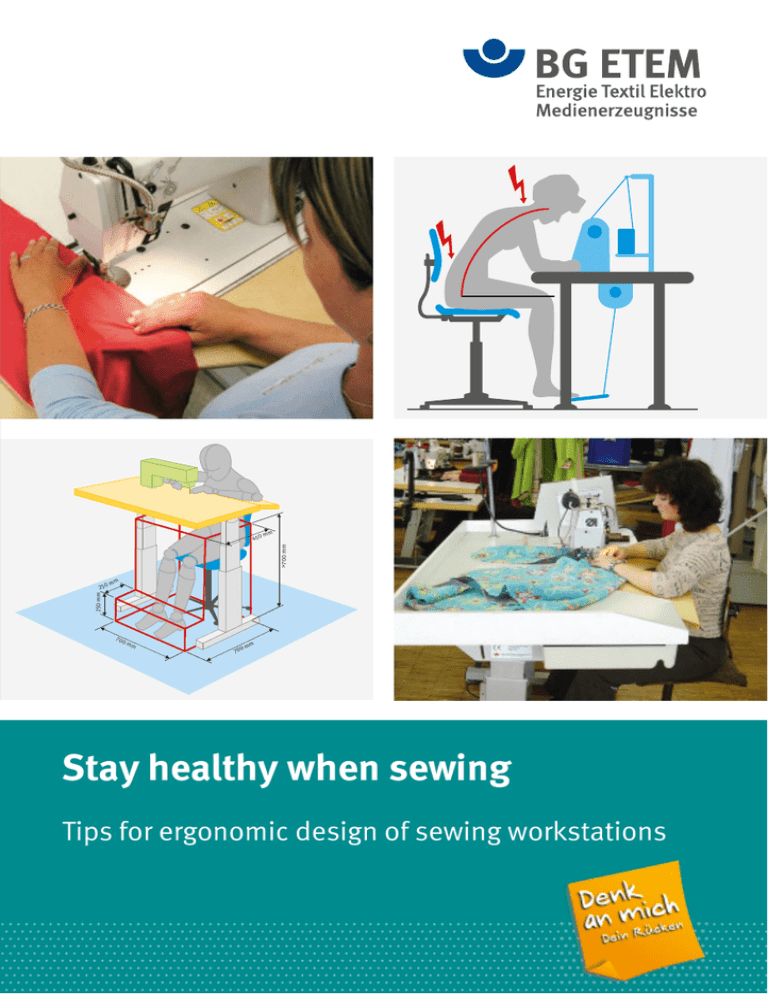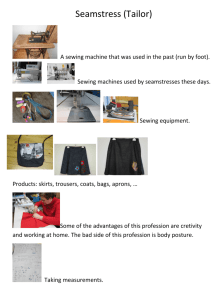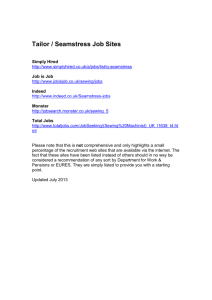
700 mm
mm
450
v
mm
250 mm
2 50
700
m
m
0
70
mm
Stay healthy when sewing
Tips for ergonomic design of sewing workstations
Stay healthy when sewing – Tips for ergonomic design of sewing workstations
Starting situation
If the height of the table, including the sewing machine, is too low, the worker must hunch
forward in order to properly view the sewing needle. In such a position it is difficult to operate
the treadle.
At sewing workstations it is frequently encountered that the worker is sewing with a curved or
twisted back and has restricted leg room. As a result we see headaches, spinal discomfort
and tension in the shoulders and neck as well as pain in the hands, arms, legs and feet.
2
Stay healthy when sewing – Tips for ergonomic design of sewing workstations
1000 mm
700 mm
1000 mm
Possibilities for improvement
Sewing should comprise of as few one-sided physical stresses on the worker as possible.
These stresses are caused by poor posture and by monotonous, repetitive movements.
An ergonomically designed workstation makes working less tiring and avoids long-term
physical damage to the musculoskeletal system.
Ergonomic improvements to existing workstations can often be achieved by taking a few
corrective measures.
When rearranging or designing a new workstation, the size of the worker and the sewing task
must be taken into account in addition to other factors.
The following chapters provide guidance on:
• Chair and posture
• Treadle and leg room
• Correct height of table
• Arm support
• Visibility and tilt-adjustable tables
• Lighting and surroundings
• Combination sit and stand sewing workstations
3
Stay healthy when sewing – Tips for ergonomic design of sewing workstations
Chair and posture
ca. 25°
ca. 95°
Height of table
Height of chair
ca. 90°
Treadle height
Swivel chairs for workstations are approved in accordance with the DIN 68877 standard.
These chairs are adjustable in height, seat tilt, and backrest position and their backrest is
padded. They facilitate the necessary work and support the worker’s spine.
One must bear in mind the size of the worker when determining the height of the chair and
the position of the treadle. The height of the chair and position of the treadle must permit the
worker to occupy the seat with a straight sitting posture.
The worker’s foot should be able to easily operate the treadle. The angle of the knee should
be slightly greater than 90 degrees and the thighs should be horizontal.
When sewing, one should not remain permanently in a certain position but rather be
dynamic. This means to change sitting positions occasionally from front to centre of the seat
and to lean back to relax.
Of course moving in order to transport material and facilitate material flow, taking work
breaks and changing work tasks, all help to alleviate the one-sided physical stress on the
worker.
4
Stay healthy when sewing – Tips for ergonomic design of sewing workstations
Treadle and leg room
Recommended measurements
for the leg room
700 mm
mm
450
v
mm
250 mm
250
700
m
m
m
0m
70
Many sewing tables have a moveable treadle fixed on a traverse. Using screws the treadle
can be mounted to the front or rear.
Even with a medium sized worker, it may be necessary to move the traverse to the far edge of
the table in order to permit the worker to have a comfortable leg position.
Sufficient space under the table allows the worker to move their feet to an optimal position
and thereby avoid excessive bending of the upper body.
Hence, components such as the motor, operating devices or drawers should not be installed
under the table top because they project into the leg area.
5
Stay healthy when sewing – Tips for ergonomic design of sewing workstations
700 mm
1000 mm
Correct height of table
Maximum and minimum
height of table at a
flatbed sewing machine
when sitting down: to the
left a tall person doing
high-degree precision
work, i.e. keeping a
smaller distance
between the eyes and
the table – to the right a
small person doing
simple sewing work, i.e.
keeping a larger distance
between the eyes and
the table.
The height of many sewing tables is adjustable by turning a screw. However, a table frame
with electronic infinite adjustment of the height is more comfortable. The height of the table
should allow the worker to sit in a comfortable upright position. If the table is too low,
workers will have to hunch forward, putting strain on the back, neck and shoulders. If the
table is too high, workers will have to raise their shoulders to get their arms high enough to
work. This posture puts strain on the neck, shoulder and arms.
Therefore, the fitting of the table base and thus the working height of the table top should be
fixed so that the worker can sit in an upright position and can reach and see all work areas,
especially the sewing needle.
If the height of the table is too low and not adjustable, an increase of height by simple means
is also possible (e. g. a foundation under the feet of the table or blocks).
6
Stay healthy when sewing – Tips for ergonomic design of sewing workstations
Arm support
During sewing, the upper arms should loosely hang at a forward angle plus, depending more
or less on the sewing task, the shoulders should be braced (without force).
The worker should be able to comfortably rest their forearms without pressure on a large
working area (with well-rounded table edges).
Newly developed, ergonomically designed sewing tables have adjustable arm supports
where you can rest your forearm. This may be particularly useful for long and uniform sewing
tasks and by high volume.
Of course you may want to fix a self-made or a purchased kit to the top of the sewing table for
arm support.
7
Stay healthy when sewing – Tips for ergonomic design of sewing workstations
Visibility and tilt-adjustable tables
Angle of head position
0°
25°
40°
30°
Optimal field of vision
When viewing of the sewing area is restricted by the head of the sewing machine, it can
cause awkward and excessive stooping.
New sewing tables can often be tilted to improve the visibility of the work area.
To obtain a slight tilt to your existing table, you can install a wedge between the table top and
the base.
You should take into account the viewing distance between the head and the needle (for
small pieces and fine work approx. 30 cm and with larger pieces about 30 cm to 50 cm) in
order to obtain the best possible sewing position. The head should be inclined forward at a
max. 25°.
8
Stay healthy when sewing – Tips for ergonomic design of sewing workstations
Lighting and surroundings
Ceiling Lighting
Window
When setting up the sewing machine, the direction of view should be parallel to the front of
the window and the ceiling light strips.
The ambient lighting should provide sufficient brightness in the work area (e. g. ceiling
lighting, 500 lux).
Additional lighting or lighting on the workplace should be arranged in order to avoid high
contrasts (differences in brightness).
It is recommended to have a minimum illumination of 1000 lux in the sewing area.
9
Stay healthy when sewing – Tips for ergonomic design of sewing workstations
Combined sit and stand sewing workstations
A frame which allows you to adjust the height of the sewing machine fulfills the requirements
for an optimal sewing workstation and also allows you to change between sitting and
standing thereby reducing one-sided and mainly static posture.
Frequent changes of position during a work task as well as varying your tasks, reduces stress
and eliminates strains and activates different groups of muscles. Movements such as these
reduce fatigue and tension and enable regeneration.
This enhances the performance of the employee and brings economic benefits to the
company.
10
Stay healthy when sewing – Tips for ergonomic design of sewing workstations
Check list for evaluating the sewing workstation
Yes
No
Is a suitable work chair in accordance to DIN 68877 with a dynamic
backrest, when possible, being used?
Is the work chair properly adjusted?
Is the area for legs and feet free of impeding fixtures?
Can the treadle be adjusted in depth?
Is the treadle positioned far enough to the front and centered under the
needle?
Can both feet be placed on a sufficiently large area (foot pedal /
auxiliary plate)?
Can the work table be titled and adjusted in height?
Is the height of the table properly adjusted for the worker?
Has the form and size of the table been correctly determined for the
sewing task?
Can the sewing task be completed without excessive bending of the
upper body and with changes in posture?
Can work be comfortably completed within easy reach?
Is overstraining of joints, arms as well as the shoulders, avoidable?
Can the task be completed with different posture positions (sitting,
standing, walking)?
Does the task include activities which relieve strain?
Can a comfortable viewing position be maintained?
Is there sufficient lighting available?
Is glare and shadow preventable?
Is there enough leg and foot space available while sitting and standing?
11
German Social Accident Insurance
Institution for the energy, textile,
electrical and media products sectors
Gustav-Heinemann-Ufer 130
50968 Köln
Telephone +49 221 3778-0
Telefax
+49 221 3778-1199
E-Mail
info@bgetem.de
www.bgetem.de
Order Nr. T 013 E
4 · 2 (13) · 04 · 13 · 5 – All rights reserved
Printed on paper from sustainable forestry
Here you can receive further information regarding
ergonomics at sewing workstations:
• Brochure: "Ergonomie an Näharbeitsplätzen –
Ratgeber für die Praxis"(BGI 804-2). With extensive explanations, tables, pictures and images
(Only in German available)
German Social Accident Insurance Institution for
the energy, textile, electrical and media products
sectors
For inquiries:
Department for textile/shoe sectors
textil@bgetem.de
Department for occupational medicine and
occupational diseases
arbeitsmedizin@bgetem.de
Recommendations for
the design of new
sewing workstations
• The table surface form and size is appropriate for
the work piece
• Sewing table / frame can be adjusted in height
and tilt
• Adjustment mechanisms are easy to use and
comfortable to reach
• There is good visibility to the needle area
• The foot mechanism is easy to operate
• There is an appropriate swivel chair to work on
• There is appropriate amount of room for movement while sitting and standing
Improvement to existing
workstations
• Use adjustment devices /mechanisms
• Attach arm supports
• Move the mounting of the treadle
• Supplement accessories (e. g. lighting or
attachments)
• Obtain new ergonomically correct facilities such
as table frame or chair
Financial outlays quickly pay for themselves
against the background of avoidable loss of
performance or even ailments/ illness.




